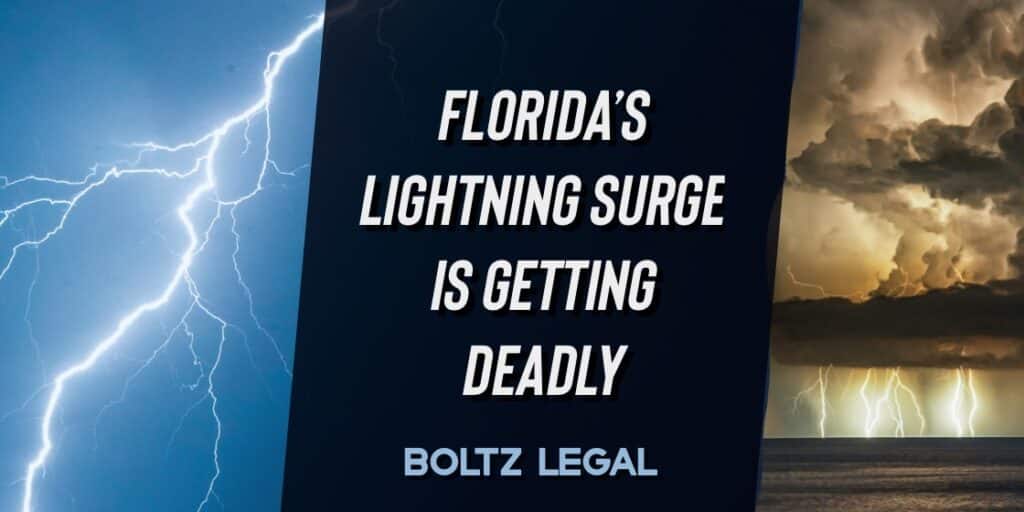There’s something different in the Florida sky.
Long known as the lightning capital of the U.S., Florida is now seeing storms that are not just frequent—they’re ferocious. The strikes are louder. The bursts are brighter. And the consequences are becoming increasingly tragic. In the past year alone, homes have caught fire, trees have exploded in suburban front yards, and vacationers on once-peaceful beaches have become victims of fatal lightning strikes.
At Boltz Legal, we believe it’s time to talk about what the data is showing and what it means for communities, property owners, and everyday Floridians. Because while the storms are natural, the fallout is deeply personal.
📊 The Numbers Don’t Lie
Let’s start with the facts.
According to NOAA’s historical climatology, Florida averaged around 600,000 cloud-to-ground lightning strikes annually between 1986 and 1995. These storms were seasonal and expected. But something has shifted. By 2004, lightning counts nearly doubled to over 1.3 million strikes statewide, and that trend hasn’t stopped.
Fast-forward to 2024, and Polk County alone saw 852,000 strikes, as reported by Vaisala Xweather’s U.S. Lightning Report. For context, that’s more lightning in one Florida county than in many entire states combined.
Why does this matter? Because with rising population density and the increased severity of these strikes, the risks are no longer just statistical. They’re personal. They’re local. They’re ours.
⚡ Not Just More Strikes — Stronger Ones
More concerning than the quantity is the quality of lightning we’re seeing. Reports from FOX 35 Orlando and NOAA indicate an uptick in positive lightning — a rarer but more dangerous type. These bolts carry up to 10 times more electrical current than negative lightning and can travel up to 10 miles away from a storm cloud.
This means people standing under clear blue skies have been hit with no visual or audible warning. It also means property damage is more severe, and fires are more common. Lightning is no longer just a flash in the distance. It’s a direct, uninvited guest.
🏖️ A Tragedy on New Smyrna Beach
On June 23, 2025, the danger turned deadly.
A 29-year-old man visiting New Smyrna Beach with his wife on their honeymoon was struck by lightning while standing in ankle-deep water. There were no storm clouds overhead, just the sudden, brutal crack of a bolt from nowhere. CPR was performed on the beach, but tragically, he passed away the next day.
This wasn’t just another statistic. It was a young life cut short. A honeymoon turned into heartbreak. And a warning that no beachgoer should ignore.
🌳 Lightning in Our Own Yards
This surge isn’t just hitting headlines—it’s hitting home.
In a small gated community in Edgewater, Florida, a single storm led to multiple trees being struck across several properties. One massive palm tree in particular was split and scorched in a front yard, visible from the street the next morning.
Watch the moment lightning struck in Edgewater, caught on video by a local resident:
Lightning Strikes Tree in Volusia County (ClickOrlando) Neighbors stood in awe and concern.
“There was this unbelievable crack of thunder, like a bomb went off,” one resident recalled. “Minutes later, another tree up the block was hit. We weren’t sure if we should stay inside or start running for cover.”
These aren’t rare events anymore. NOAA’s National Severe Storms Laboratory notes that over 80% of lightning strikes during clustered storms happen within just 2 to 3 miles of each other. That means if one tree is hit on your block, several more could be next.
⚖️ Legal Implications and Community Safety
At Boltz Legal, we believe preparation starts with information.
For homeowners, especially those in HOAs or gated communities, now is the time to revisit your insurance policies. Are trees covered? What if a branch crashes into your neighbor’s roof? Does your policy account for electrical fires or storm surge damage linked to lightning?
Communities should also consider investing in lightning detection systems, updated weather protocols, and even neighborhood safety briefings during peak summer months.
As lawyers, we can’t stop the storm—but we can help you weather the aftermath. If your home or property has been damaged by a lightning strike, Boltz Legal can handle your insurance claim from start to finish—ensuring you get the compensation you deserve without unnecessary delays or denials.
🌍 Florida Is Changing. Stay Grounded.
Whether you’re a beachgoer, a homeowner, or simply someone who watches the afternoon sky, Florida’s lightning surge is a growing concern. But it doesn’t have to catch us off guard. With the right awareness, preparation, and legal guidance, we can protect what matters most.
If you or your community has experienced damage or injury related to lightning, contact Boltz Legal today. Your rights matter. And your recovery starts with the truth.
🗋 Sources
- NOAA/NWS Melbourne, Florida Lightning Climatology (1986–1995)
- NOAA-AMS study, Monthly Lightning Trends in Florida (1989–2004)
- Vaisala Xweather, 2024 U.S. Lightning Report
- AGU Geophysical Study, High-Rate Flash Bursts in Florida Storms
- FOX 35 Orlando, Florida’s Lightning Is Louder, Stronger, More Dangerous
- ClickOrlando, Man Struck by Lightning on New Smyrna Beach Dies (June 23, 2025)
- NSSL Lightning Strike Clustering Research
- Edgewater eyewitness video – Lightning Strikes Tree in Volusia County

